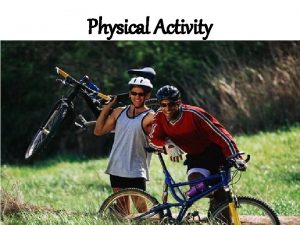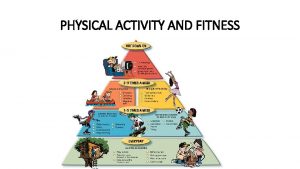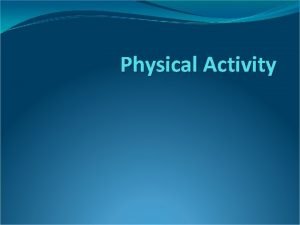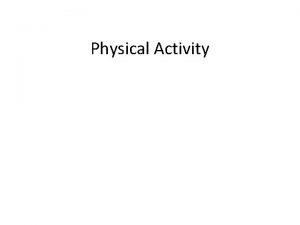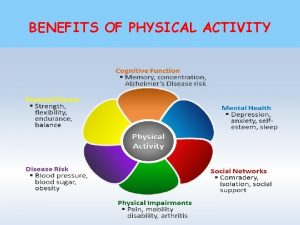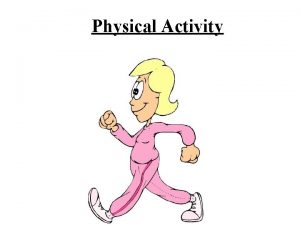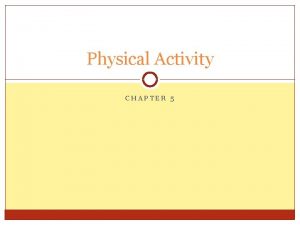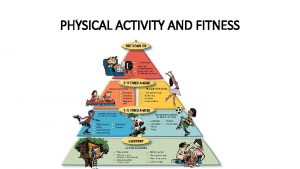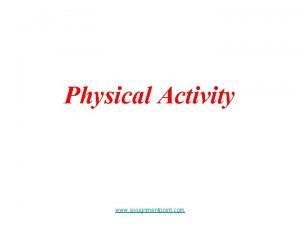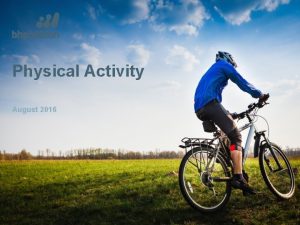The importance of Physical Activity Section 13 1


















- Slides: 18

The importance of Physical Activity Section 13. 1

• MYTH: Being thin is a sign of fitness • FACT: Appearance is not a good indicator of overall fitness. Thin people who do not exercise are likely to have poor heart, lung, and muscular fitness. • Why, you ask? … read on…

Benefits of Physical Activity • Any movement that requires your large muscle groups to work is considered physical activity. • Teens should spend 60 minutes or more each day performing some form of physical activity. • The changes that occur due to physical activity are beneficial to your body, your mind, and your social interactions.

Physical Benefits • Cardiovascular System Your heart and blood vessels receive the most benefits from regular physical activity. • Weight Maintenance Staying at a healthy weight can reduce your risk for developing diseases such as diabetes, heart disease, and certain cancers. • Bone Strength Your physical activities make your bones stronger and denser. • Balance and Coordination Physical activity improves your balance and coordination, which may, in turn, improve your athletic ability.

Psychological Benefits • During continuous exercise, your brain releases endorphins, chemicals that block pain messages from reaching your brain cells. • People who exercise regularly are likely to be more self-confident and focused, and have reduced stress levels.

Social Benefits • Exercise is also an opportunity to have fun. • Physical activity can be a way to bond with family and friends or build new relationships.

The Components of Fitness • Physical fitness means that you have the energy and strength to participate in a variety of activities. • There are five components of fitness: • • • cardiorespiratory endurance muscular strength muscular endurance flexibility body composition

Cardiorespiratory Endurance Cardiorespiratory endurance means that your heart, blood vessels, and lungs are able to distribute nutrients and oxygen and remove wastes efficiently during prolonged exercise. • As the heart muscles become stronger, more blood is pumped with each beat. • The lungs become more efficient at delivering oxygen to the blood and removing carbon dioxide.

Muscular Strength • The capacity of a muscle or a group of muscles to produce force is called muscular strength. • The amount of weight you can lift is one measure of your muscular strength.

Muscular Endurance • Muscular endurance is the ability of your muscles to work for an extended time. • Developing muscular endurance requires repeated actions over an extended period of time.

Flexibility • The ability to move a joint through its entire range of motion is called flexibility. • This means that you can bend, stretch, and twist your body easily. • Stretching exercises, if done correctly, can increase flexibility and may reduce the risk of injury during exercise.

Body Composition • Body composition is the amount of fat tissue in your body compared to the amount of lean tissue, such as muscles and bones. • Having too much, or too little, body fat can lead to health problems.

Types of Physical Activity • Physical activities can be classified as aerobic exercise or anaerobic exercise. • Strengthening and endurance activities can be further classified as isometric exercise, isotonic exercise, or isokinetic exercise.

Aerobic Exercise • Ongoing physical activity that raises your breathing rate and heart rate is called aerobic exercise (ehr OH bik). • Aerobic exercises increase the amount of oxygen that your body takes in and uses.

Anaerobic Exercise • Intense physical activity that lasts for a few seconds to a few minutes is called anaerobic exercise. • Most anaerobic exercises develop muscular strength, muscular endurance, or flexibility.

Isometric Exercise • Isometric exercise (eye suh MET rik) is an exercise in which muscles contract but very little body movement takes place. • If you do isometric exercises on a regular basis, the muscles you use will become stronger.

Isotonic Exercise • Isotonic exercise (eye suh TAHN ik) involves contracting and relaxing your muscles through the full range of a joint’s motion. • Through repetition of isotonic exercises, you can develop muscular strength and endurance.

Isokinetic Exercise • In isokinetic exercise (eye soh ki NET ik) muscles contract at a constant rate. • These exercises are often used as therapy to rebuild muscle strength after an injury.
 Physical fitness components and tests grade 9
Physical fitness components and tests grade 9 Hát kết hợp bộ gõ cơ thể
Hát kết hợp bộ gõ cơ thể Frameset trong html5
Frameset trong html5 Bổ thể
Bổ thể Tỉ lệ cơ thể trẻ em
Tỉ lệ cơ thể trẻ em Gấu đi như thế nào
Gấu đi như thế nào Tư thế worms-breton
Tư thế worms-breton Hát lên người ơi alleluia
Hát lên người ơi alleluia Môn thể thao bắt đầu bằng từ chạy
Môn thể thao bắt đầu bằng từ chạy Thế nào là hệ số cao nhất
Thế nào là hệ số cao nhất Các châu lục và đại dương trên thế giới
Các châu lục và đại dương trên thế giới Công thức tiính động năng
Công thức tiính động năng Trời xanh đây là của chúng ta thể thơ
Trời xanh đây là của chúng ta thể thơ Cách giải mật thư tọa độ
Cách giải mật thư tọa độ 101012 bằng
101012 bằng Phản ứng thế ankan
Phản ứng thế ankan Các châu lục và đại dương trên thế giới
Các châu lục và đại dương trên thế giới Thơ thất ngôn tứ tuyệt đường luật
Thơ thất ngôn tứ tuyệt đường luật Quá trình desamine hóa có thể tạo ra
Quá trình desamine hóa có thể tạo ra



















